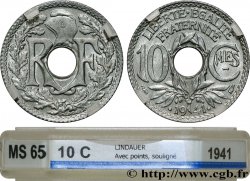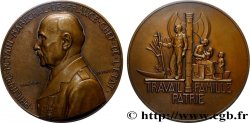v30_1197 - Préparation de la 10 francs Pétain, type Turin, essai en aluminium, tranche striée, léger 1938 Paris VG.cf. 5489 c
MONNAIES 30 (2007)
Startpreis : 200.00 €
Schätzung : 800.00 €
Erzielter Preis : 742.00 €
Anzahl der Gebote : 7
Höchstgebot : 1 107.00 €
Startpreis : 200.00 €
Schätzung : 800.00 €
Erzielter Preis : 742.00 €
Anzahl der Gebote : 7
Höchstgebot : 1 107.00 €
Type : Préparation de la 10 francs Pétain, type Turin, essai en aluminium, tranche striée, léger
Datum: 1938
Name der Münzstätte / Stadt : Paris
Metall : Aluminium
Durchmesser : 28, 01 mm
Stempelstellung : 6 h.
Gewicht : 2,37 g.
Rand striée
Seltenheitsgrad : R2
Kommentare zum Erhaltungszustand:
Infimes traces de manipulation, flans miroir
N° im Nachschlagewerk :
Vorderseite
Titulatur der Vorderseite REPUBLIQUE - FRANÇAISE.
Beschreibung Vorderseite Tête de la République à droite, coiffée d'un bonnet phrygien lauré ; signé P. TURIN sous le buste.
Rückseite
Titulatur der Rückseite 10 / FRANCS / 1938 / LIBERTE / EGALITE / FRATERNITE // ESSAI .
Beschreibung Rückseite En sept lignes, entre deux épis de blé verticaux.
Kommentare
Poids léger. Compte tenu du métal, de la date et des autres pré-séries connues, on peut être pratiquement certain que ce type fut utilisé pour mettre au point les 10 francs Pétain, bien qu’il reste possible que ces essais datent de l’immédiate avant-guerre et aient été effectivement destinés à frapper des Turins en aluminium. A contrario, il semble que les réquisitions de métaux n’aient pas été imaginés avant-guerre, donc que l’usage de l’aluminium indique la période de guerre. Si nous avons effectivement affaire à des essais de frappe de 10 francs Pétain, ces essais, du fait de leur métal, sont postérieurs aux essais de frappe au type 1939/1929 puisque ceux-ci n’envisageaient pas encore le rationnement du cuivre et du nickel.
Lightweight. Given the metal, the date and other known pre-series, we can be practically certain that this type was used to develop the 10 franc Pétain, although it remains possible that these tests date from the immediate pre-war period and were actually intended to strike aluminum Turins. On the contrary, it seems that the requisitions of metals were not imagined before the war, so the use of aluminum indicates the war period. If we are indeed dealing with test strikes of 10 franc Pétain, these tests, because of their metal, are later than the test strikes of the 1939/1929 type since these did not yet envisage the rationing of copper and nickel
Lightweight. Given the metal, the date and other known pre-series, we can be practically certain that this type was used to develop the 10 franc Pétain, although it remains possible that these tests date from the immediate pre-war period and were actually intended to strike aluminum Turins. On the contrary, it seems that the requisitions of metals were not imagined before the war, so the use of aluminum indicates the war period. If we are indeed dealing with test strikes of 10 franc Pétain, these tests, because of their metal, are later than the test strikes of the 1939/1929 type since these did not yet envisage the rationing of copper and nickel








 Berichten über einen Fehler
Berichten über einen Fehler Die Seite drucken
Die Seite drucken Teilen meiner Auswahl
Teilen meiner Auswahl Stellen Sie eine Frage
Stellen Sie eine Frage Einlieferung/Verkauf
Einlieferung/Verkauf
 Details
Details









